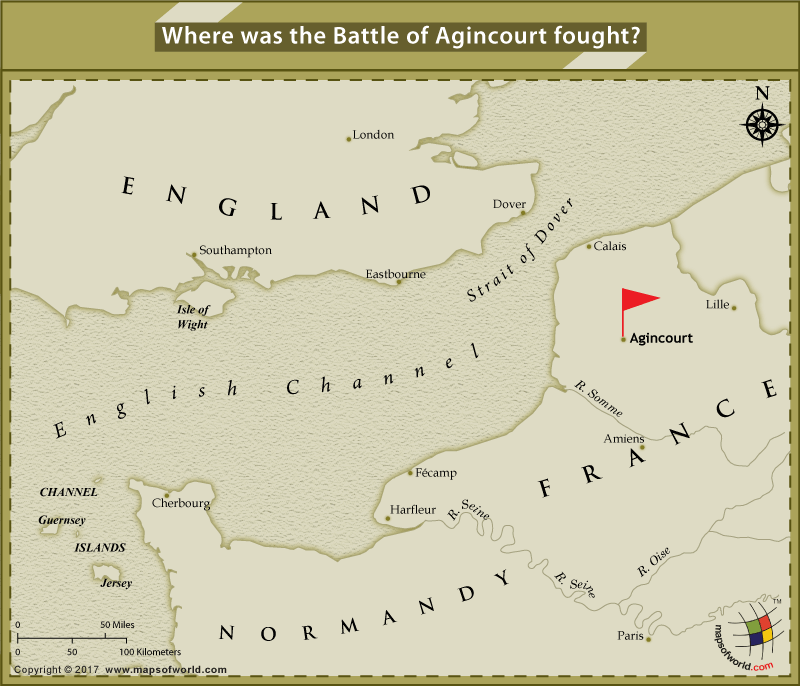

Location map of Agincourt fort on the France & England Map
The Battle of Agincourt, one of the numerous conflicts fought between the French and the English armies in the course of the Hundred Years’ War. The victory secured by Henry V, the young king of England, against a French army that vastly outnumbered his own, is recounted among England’s most glorious military successes. The battle took place on a field in Agincourt (Azincourt, in the county of Saint-Pol, 25 miles, or approximately 40 kilometers) south of Calais.
In 1413, when the 27-year-old Henry V succeeded his father to the throne of England, he also inherited a legacy of conflict with France. England had been embroiled in a series of conflicts with France since 1337. These conflicts would last till about 1453, and are now referred to as the Hundred Years’ War. Eager to reclaim territory lost to the French over many years, Henry V and his men crossed the English Channel and landed in Normandy, near the mouth of the Seine, in August 1415. Despite the successful siege and capture of Harfleur (Normandy) the English army had lost a number of men – some on the battlefield and some due to disease. Intending to return to England (through the port of Calais) with the help of the English Fleet, Henry V marched his men towards northern France. Blocking their way in Agincourt, however stood a French army of approximately 12,000 to 36,000 men (according to varying records). Henry V had about 6,000 to 9,000 troops with him at the time. The English soldiers were also weary and exhausted. King Henry V, however, decided to take advantage of the natural settings of his battlefield.
The English Army met the French troops on October 25th, 1415, in a large field which had recently been ploughed but was left muddied and slushy by rain the previous night. The field was wedged between woodlands on either side. Henry’s army consisted largely of archers. He marched his army precariously close to the French troops. His archers then let lose a volley of arrows injuring many French soldiers at a go. The French army consisted largely of knights on horseback and foot soldiers. The muddy quagmire became the worse enemy for the French than the English themselves. As the French troops drew their swords and charged, they realized that the field was a narrow one and the long lance-like swords could not be comfortably swung with more troops charging from behind. English archers put the confusion to great use and managed to slay a great many French soldiers. When they exhausted their arrows, they drew their swords and joined the English knights in their attack. The French army was decimated and retreated.
Some 5,000 French soldiers were killed on the battlefield, while the English lost merely 400. A number of reasons accounted for this overwhelming defeat of the French – from the heavy cumbersome armors they wore to their complacence, and lack of authority of the French leaders on the battlefield. These, however, do not take away the exceptional courage of the English soldiers and strategic superiority of King Henry V in the course of this battle.
Related Maps:
The Republic of Madagascar is an island country located in the Indian Ocean, off the…
The Euro is the official currency of the European Union. It is, however, not incumbent…
There are many countries or regions that are partially recognized by the UN, have disputes…
The Alaska Statehood Act was signed into law by President Dwight D. Eisenhower in 1958,…
The name Persia may, however, only be used to refer to Iran in some contexts.…
Hawaii is an Island State in the US. It is one of the 50 states…